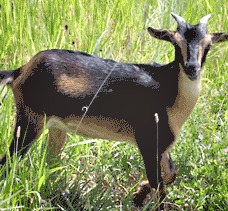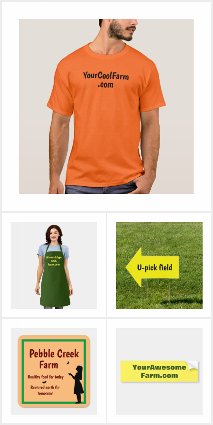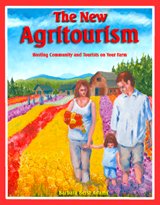Four lesser known goat breeds...
 San Clemente Island goat
San Clemente Island goatby Barbara Berst Adams. A version of this article was first published in AcresUSA. Copyright National Lilac Publishing, LLC
This article briefly introduces four less common goat breeds that farmers and homesteaders may be interested in considering. On working farms and homesteads, livestock become part of the regenerative farming story when they “earn their keep” by providing a usable crop for sale or barter. Along with valuable manure, goats of many breeds have historically provided all or some of the following for their human stewards: Milk, fiber/hides, show/breeding stock for sale, meat, agritourism customer draws, cart pulling/pack animals for sale or rent, and brush clearing and woodland wildfire mitigation services for sale. For each breed described here, one particular stand-out crop or service will be highlighted.
Pygora
Pygora goats are crosses between the Pygmy goat and Angora goat that have been accepted and registered by the Pygora Breeders Association (PBA). Its main crop and purpose for most breeders is its unusual soft, fine wool for handspinning. According to the PBA, the wool of Pygoras doesn’t get coarser as the goat ages. Although authentic Pygoras breed true as their own breed, goat owners can also start their own “first generation” Pygoras by breeding a registered Pygmy goat with a registered Angora goat, as long as the resulting offspring meet the size and fleece standards. First generations can be registered with the PBA, and though they aren’t considered true Pygoras and maintain crossbreed status, their subsequent offspring can be registered as Pygoras if they meet qualifying standards.
According to the PBA, birth weight is about 5 pounds, with does averaging 80-120 pounds and bucks and wethers (neutered males) averaging 75-140 pounds. There’s no maximum height restriction, but the minimum height for registration is 18 inches for does and 23 inches for bucks. Does and bucks both have horns, but many people disbud them at a young age, so it’s common to see Pygoras without horns.
There are three fiber categories. Type A is closest to the long, lustrous Angora goat mohair, about six inches in length. (The wool from Angora goats is called mohair, whereas the wool from Angora rabbits is called Angora wool). Type B fiber is the most common in Pygoras and grows three to six inches long. It still has mohair-type luster and curl, and is very fine and soft. It’s also curled and can be shorn twice a year, or combed or plucked to be harvested. Plucking means to gently pull out the fiber when it’s already naturally shedding from the goat. Type C is the finest of all. With the shortest length, one to three inches, it is matte with no, or less, luster. When shorn, which automatically gathers the stiff guard hairs along with the softer fleece, the guard hairs are usually removed because they contrast too strongly with the downy softness of this type of fiber. Type C wool can also be plucked or combed, though, which tends to remove the down and leave the guard hairs behind.
Pygora fiber comes in the many natural colors of a Pygmy goat including various white shades. However, a portion of the color seen on the goat before harvesting the fleece can come from the guard hair which is often removed, depending on the goal of the fiber product and category of fiber so the harvested fleece may be lighter.
Although lactating Pygoras can be milked, with owners reporting receiving about a quart per day, they are bred for fiber vs. milking ability and udder quality, and some owners remark it can be a challenge to milk them.
Colored Angora
The main niche crop from naturally colored Angora goats is handspinners’ fleece, used for everything from next-to-the-skin garments to handmade throw rugs to doll hair. The owners of Prairie Lake Farm in Minnesota share the story of how they started out raising llamas, which included sheering their fiber, pooling it with other llama owners, and processing it into yarn. But once they added Angora goats and sheared them as well, they realized they could benefit more financially with the goat fleece, and they now concentrate on colored Angora goats.
Pure white Angora goats are well known and their fleece is valuable in the mohair industry where it’s dyed in large amounts for producing consistent results. Any fleece color at all on the goats automatically disqualifies them from being registered with the American Angora Goat Breeders Association. But many goat breeds, including Angoras, naturally produce a variety of pigments. And when the niche of naturally colored non-dyed fleece grew in popularity, it no doubt inspired people to reconsider colored mohair as a niche crop.
According to the American Colored Angora Goat Registry, Angora goats that were otherwise purebred but also had colored fleece started being saved from slaughter in verifiable numbers in the late 90s, and further bred. The interest and number of goats grew (both from continued breeding and more rescues) until registries and associations were developed.
Mature bucks are usually 180 to 225 pounds and mature does 70 to 110 pounds. They put much of their energy into producing the long fleece instead of body mass, and therefore aren’t raised specifically for meat. Nor are they a dairy breed. Although virtually any healthy lactating goat can be milked, the few goat owners I’ve come across who have milked Angora goats got very small amounts. Also, some owners noticed when their goats were lactating and feeding their young, energy for producing wool seemed to be temporarily compromised for milk production until the young were weaned.
The Colored Angora Goat Breeders Association states that, in general, the colors have two classification categories: blacks and reds. They describe the colors as follows: “Blacks include goats with fleeces that range from a deep solid black to light grays and silvers. They also come in a variety of patterns. The most common patterns are: solid; reverse badgerface; white/tan stripes through the eyes; and white/tan chin and belly on a silver to black goat. Reds are often called “faded reds” because the color of the fleece lightens significantly as the goat ages. Fortunately the color doesn’t fade away completely from all red goats. The fleeces range from apricot to copper. Red goats are generally solid color. Color patterns include the combinations mentioned previously.”
Angora goat farmers further describe colors in various browns ranging from light beige to chocolate. Some who have raised colored Angora goats for years confirm that the fleece color changes with the age of the goat. Many say the colors fade, and one even said they’d seen the color get darker with age. This most likely puts colored mohair in a niche crop category with a market that accepts surprises, and unique value added products that may change from year to year, vs. a crop that produces large quantities with a consistent attribute.
Nigerian Dwarf Dairy Goats
As the name implies, Nigerian Dwarf dairy goats are quite small. Even so, their niche crop is unique high quality goat milk, with udder quality a strong part of their breeding. They can even be used for smaller scale commercial milk production. Although reported to produce only one to two quarts of milk per day due to their smaller size, they consume less, and their creamy milk is high in butterfat and considered to be of excellent quality. They can also make good companions to other goat breeds. On Left Foot Farm in Eatonville, Washington, raw goat milk is processed in small batches and sold locally. With about 100 dairy goats of various breeds on the farm’s 25 acres, owner Jeremy Foust told me that Nigerians were the farm’s foundation, and they currently have about 40 in the herd.
Unlike goats that can only be bred seasonally, which can produce a glut of milk and an off-season, Nigerians can be bred year round, allowing for staggered breeding for a more consistent supply.
Usually only a bit under or over 20 inches and around 75 pounds with the males slightly larger, there is debate amidst breeding groups over the allowable size for registration. This may have to do with some groups emphasizing milk production so therefore allowing larger sizes, and companion animal breeders more interested in maintaining smaller sizes. The breed is considered very gentle and easy to train. They’ve even been described as good service animals for hospitals and nursing homes!
Most are born with horns, although some are naturally polled (born without horns). Nigerians are more slender than the stockier Pygmy goats and closer than Pygmies to the conformation of full sized dairy goats. Their coats, which can be of several colors and patterns, have soft short to medium hair.
San Clemente Island goats
Although Pygora, colored Angora, and Nigerian Dwarf goats are all lesser known in general, San Clemente Island (SCI) goats are on the critical list of the Livestock Conservancy, which is its most serious listing regarding danger of extinction.
SCI
goats are described as gentle, excellent mothers, fine-boned,
deer-like, with horns on both sexes and only slightly larger than dwarf
goat breeds. They were once feral animals isolated on San Clemente
Island off the coast of southern California. Eventually declared a
nuisance, the process of destroying them was set in motion. When the
estimated population of 15,000 goats was decreased to about 4000, a
proposal to shoot the rest from the air was halted, and instead they
were trapped and adopted out.
Today, John Carroll and Chad Wegener (photo of one of their goats above) are currently raising the largest herd in the world on their Willow Valley Farms in Gretna, Nebraska, with Wegener operating the farm full time. With the value of livestock genetic diversity understood now more than before, San Clemente goats may indeed have unique genetics very worth preserving. The following is from the Livestock Conservancy: “although their large horns resemble those of Spanish goats, San Clemente goats are not of Spanish origin. The Livestock Conservancy, in collaboration with the University of Cordoba in Spain, conducted a DNA study of the breed in 2007 and found that the San Clemente goat is a genetically distinct breed and unrelated to the numerous other breeds in the study. The findings raise many questions about the origin of the San Clemente goat and further study is needed to gain a better understanding of this unique breed.”
The three other goat breeds described here produce a specialty crop of milk or fiber, but most past efforts for San Clemente goats have been about keeping them from extinction. So the next project for Willow Valley Farms is to develop a niche crop from them by building a dairy to produce goat cheese. They have already experimented with milking them and making cheese, and hope to take it a step further. “We have and will continue to milk a few goats for our own consumption,” Wegener said. “We like to drink the milk and make some cheese for us to enjoy. SCI goats do not have a large udder that is typical of standard milking goats. The udder size is smaller than a soccer ball. However the SCI goat has a higher butter fat content and low whey. This is beneficial because they will milk out less waste (i.e. whey) when we milk and provide us with mostly quality milk to work with when creating cheeses (quality versus quantity). Our plans are to build a Class A micro dairy to milk, process, make, and store cheese. We hope to create a niche market with the intent to help lay the foundation for other SCI breeders across the United States to build their own micro dairy’s utilizing SCI milk for their cheese.”
Food crops from heritage farm animal breeds appear to be growing in popularity as the general population not only wants non-generic products, but some are eager to contribute to genetic diversity. So the combination of a flavorful sustainably produced goat cheese with it coming from a genetically unique endangered goat breed could hold high appeal with customers if the right market was reached.
Also, the goats may be an especially good agritourism draw for some producers. If drawing customers directly to the farm is beneficial in any way, goats are always a hit with farm visitors and especially rare ones can add to the attraction. I don’t advocate the meaningless petting zoo idea and believe it’s preferable that agritourism activities represent what the farm actually raises for crop harvest. But if the farm is helping out with farm animal rescue or livestock genetic diversification, and the animals draw customers which ultimately add to the farm’s revenue, the valuable goat manure and brush clearing ability of goats may prove sustainable to a farm that otherwise doesn’t raise goats or harvest other crops from them.
For further information about any of these four breeds, newcomers to goat care can begin by learning about general holistic domestic goat care first. The book, Holistic Goat Care by Gianaclis Caldwell is great to start with. Goats have very different needs than other livestock, including sheep. Landowners may discover they already have the perfect set-up for goats, or discover there are actually changes that need to be made first. Then, aspiring goat owners can refine their knowledge according to the chosen specific breed. Search for breed registries and associations for your chosen breeds. They're good starting points for finding more specific breed information. They offer further reading, breeders, and events where much first hand customized knowledge can be gained.
You may also be interested in:
Starting a goat brush clearing business
Micro goat dairy starts on less than an acre
Profile of a successful organic goat ranch




